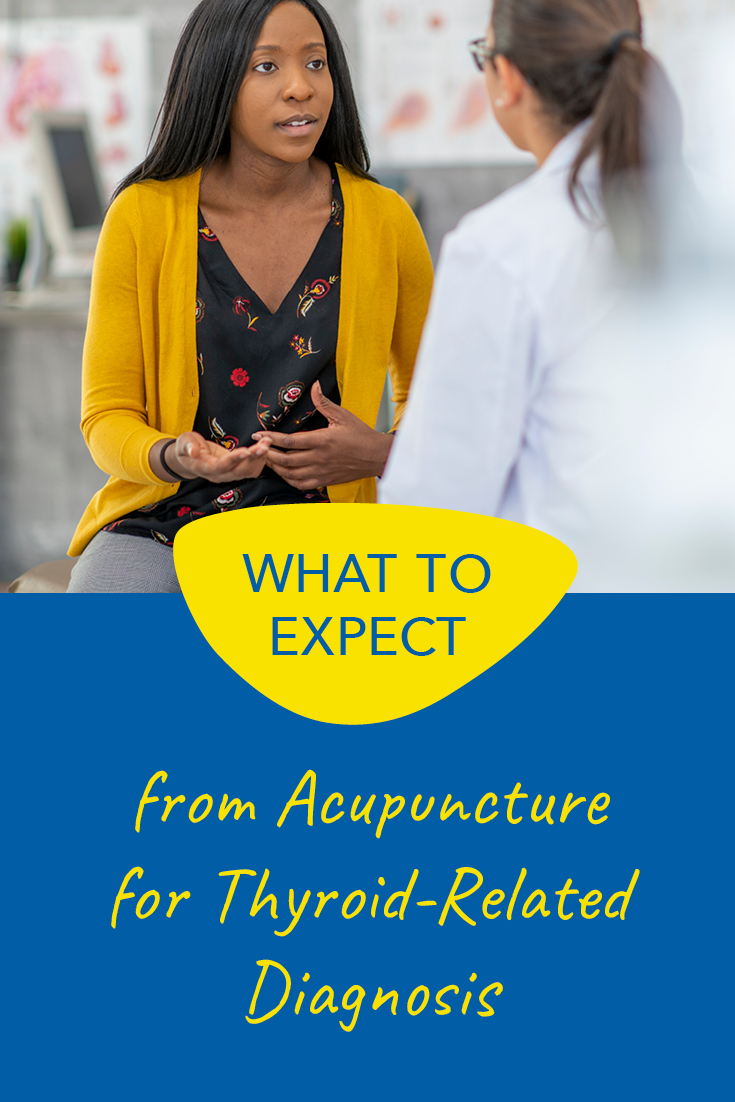Expert Advice

Acella Pharmaceuticals, LLC, is partnering with Ericca Burke, a board-certified licensed acupuncturist, to bring greater awareness to the importance of thyroid care and education. This post was sponsored by Acella Pharmaceuticals and should not be construed as medical advice. Please talk to your doctor about your individual medical situation.
Disclaimer: The information provided is for educational purposes only and does not substitute professional medical advice. Consult a medical professional or healthcare provider before beginning any exercise, fitness, diet, or nutrition routine.
Initial Interview
When a patient visits an acupuncturist for help with a thyroid-related diagnosis, the acupuncturist will start the initial visit with an interview and health-history review. This includes a discussion of past and current health conditions and medications and supplements. Any recent bloodwork results are also reviewed: for example, this would include the most recent TSH, T3 and T4 levels in the case of hypothyroidism.
The acupuncturist will ask the patient a variety of questions about their overall health and review the major organ systems of the body: integumentary (skin, hair and nails); skeletal; muscular; nervous; endocrine; cardiovascular; lymphatic; respiratory; digestive; urinary and reproductive. Nutrition, sleep and mental health also are covered. In the case of hypothyroidism, some of the discussion may focus on areas such as body temperature; weight gain; weakness or fatigue; pain, hair and nail changes; memory; and anxiety and depression.
The interview also includes a discussion of the patient’s goals for the treatment. In some cases what is most concerning to the patient may be different from what the acupuncturist might prioritize, so having insight into what the patient feels is most important. It will help the acupuncturist tailor the treatment plan to balance the patient’s needs and overall energy.
Pulses
After the interview, the acupuncturist will check the patient’s pulses. The pulses are felt on the wrist just as a western medical practitioner would take pulses. The acupuncturist will feel the pulses on both wrists and feel or “listen” to the pulses in 12 different positions. The 12 different positions correspond to the 12 different organ systems in the body. The way the pulses feel provides insight into how each organ system is functioning.
In the case of hypothyroidism, if the pulses are felt to be slow and weak, this can indicate that the spleen and kidney organ systems need to be warmed and nurtured. Or if the pulses feel taut and wiry like a guitar string, this suggests that the patient’s liver energy may be stagnant and needs to be balanced. These are just a few examples of the various pulse qualities and how they may reflect the functioning of the organ systems.
Tongue
The next step is for the acupuncturist to examine the patient’s tongue. The patient is asked to stick out his or her tongue, just like at a doctor visit. The acupuncturist will examine the size, shape, color and coating of the tongue. As with the pulses, the major organs are also represented on the tongue. Looking at the tongue gives additional insight into how the organs are processing energy.
In the case of hypothyroidism, if the tongue appears pale and swollen, this could indicate that the spleen and kidney organ systems need to be fortified. If the tongue is red, this would reflect a need to reinforce more of the yin or cooling energy in the body. If the sides of the tongue are redder than the center of the tongue, this shows a need to soothe the liver energy in the body. There are a multitude of combinations of tongue qualities that may be evident, and these are just a few possibilities of how the tongue might look in a patient who has hyperthyroidism.
Palpation
If the patient has any areas of concern that need to be examined further, the acupuncturist will often palpate those areas. Just as in palpating the pulses as described earlier, this is a light touching and pressing that can give information about the energetic state of the area. Palpation typically reveals if the energy in a particular area of the body is in a state of excess or deficiency or is stagnant. For example, an area that feels hard and painful would indicate an excess in energy. The patient’s thyroid may be palpated to determine its size as well as flexibility. Acupuncture points can also be palpated to determine if any points are tender or sensitive.
Treatment plans unique to each individual
After the interview and evaluation is complete, the acupuncturist will leave the treatment room and let the patient get comfortable on the treatment table. The acupuncturist will analyze all of the information collected from the interview, pulse reading, tongue diagnosis and any additional palpation to form a diagnosis and treatment plan. The goal of the plan will be to help restore the proper balance of energy in the patient’s body and address any concerns. For example, if patient shared that he has low back pain, feels tired and cold and has poor digestion, and his tongue is pale and swollen and pulses are slow and weak, the acupuncturist would likely focus on a treatment plan to warm and strengthen the patient’s spleen and kidney energetic channels. Because all patients are different, they will receive treatments customized specifically to their needs.

ML-0176
INDICATIONS & IMPORTANT RISK INFORMATION INCLUDING BLACK BOX WARNING
Important Risk Information
Drugs with thyroid hormone activity, alone or together with other therapeutic agents, have been used for the treatment of obesity. In euthyroid patients, doses within the range of daily hormonal requirements are ineffective for weight reduction. Larger doses may produce serious or even life-threatening manifestations of toxicity, particularly when given in association with sympathomimetic amines such as those used for their anorectic effects.
- NP Thyroid® is contraindicated in patients with uncorrected adrenal insufficiency, untreated thyrotoxicosis, and hypersensitivity to any component of the product.
- In the elderly and in patients with cardiovascular disease, NP Thyroid® should be used with greater caution than younger patients or those without cardiovascular disease.
- Use of NP Thyroid® in patients with diabetes mellitus or adrenal cortical insufficiency may worsen the intensity of their symptoms.
- The therapy of myxedema coma requires simultaneous administration of glucocorticoids.
- Concomitant use of NP Thyroid® with oral anticoagulants alters the sensitivity of oral anticoagulants. Prothrombin time should be closely monitored in thyroid-treated patients on oral anticoagulants.
- In infants, excessive doses of NP Thyroid® may produce craniosynostosis.
- Partial loss of hair may be experienced by children in the first few months of therapy but is usually transient.
- Adverse reactions associated with NP Thyroid® therapy are primarily those of hyperthyroidism due to therapeutic overdosage.
- Many drugs and some laboratory tests may alter the therapeutic response to NP Thyroid®. In addition, thyroid hormones and thyroid status have varied effects on the pharmacokinetics and actions of other drugs. Administer at least 4 hours before or after drugs that are known to interfere with absorption. Evaluate the need for dose adjustments when regularly administering within one hour of certain foods that may affect absorption.
- NP Thyroid® should not be discontinued during pregnancy, and hypothyroidism diagnosed during pregnancy should be promptly treated.
Indication
NP Thyroid® (thyroid tablets, USP) is a prescription medicine that is used to treat a condition called hypothyroidism from any cause, except for cases of temporary hypothyroidism, which is usually associated with an inflammation of the thyroid (thyroiditis). It is meant to replace or supplement a hormone that is usually made by your thyroid gland.
NP Thyroid® is also used in the treatment and prevention of normal functioning thyroid goiters, such as thyroid nodules, Hashimoto’s thyroiditis, multinodular goiter, and in the management of thyroid cancer.
